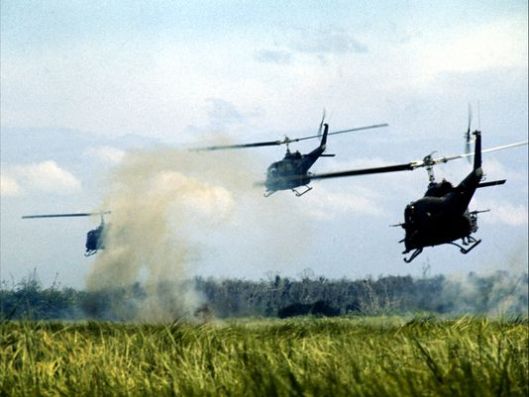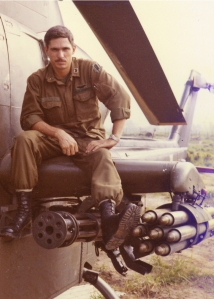Seems like yesterday, but it was 45 years ago in Vietnam when I heard Keith’s calm voice in my helmet. I was trying to spot a landing place among tree stumps without being distracted by the flashes of gunfire that were directed at the LOH (light observation helicopter). I really hated flying into “hot” LZs.
“I’m right behind you and I see “charlie” in the tree line. Stay steady buddy. I’ll take them out before you get there,” he said.
I pressed my mic button to reply, but before I could say the words “thanks man” two 2.75 inch rockets from his Cobra whooshed past my cockpit, so close it seemed I could have grabbed them. They were followed by XM 129 grenades, M134 machine gun fire and two more rockets. They exploded in front of me where I had seen the enemy muzzle flashes. I managed to land, along with my two sister ships beside and behind me. Within 20 seconds we dispatched our 18-man infantry rifle platoon, six soldiers from each Huey, and departed the LZ without incident.
After arriving in Vietnam within a couple of weeks of each other, Keith and I were assigned to B Troop, 3/17 Air Calvary, he a Cobra gunship pilot and I a Huey lift pilot. As we got to know each other, we discovered we had some things in common. We were a couple of years older than the average pilot; we enjoyed a gin and tonic before dinner, but liked a good night’s sleep without a hang-over the next morning; we listened carefully to each day’s mission briefing and planned accordingly with all the right radio frequencies, maps, and knowledge of the limitations of the overused aircraft we had to fly each day; and we were deliberate and calculating pilots who were not just trying to do a good job, but determined to get back home alive and well. These traits must have shown, because we were chosen by our Troop Commanding Officer to be the instructor pilots in our respective aircraft whereby we gave the other pilots 90-day standardization check rides and practice on in-flight emergency procedures. Keith and I became fast friends.
B Troop was made up of four platoons: AH1 cobra gunships, OH6 light observation helicopters (LOH), UH1 Huey lift helicopters, and an 18-man infantry platoon. A core Troop mission was to “seek and destroy” the enemy. Three “hunter/killer” teams (LOH/Cobra) worked the area of operation. When they found a target for which they needed the infantry platoon on the ground (bunkers, tunnels, hutches) they called the lift platoon (three Hueys) to insert the infantry.
For the last six months of my one-year tour, I served as the lift platoon leader. During a typical day, we flew 6 to 10 hours and inserted the infantry on various targets 6 to 8 times. Each landing zone was challenging in various ways. Some were covered with brush and stumps, and some with elephant grass 8 feet tall; some allowed touch down on solid ground while others had as much as 4 feet of water into which the troops jumped while we held the aircraft at a hover; and some LZs were “hot” and some not. It was the “hot” ones I worried about, but when Keith was the pilot in the gunship covering me, I was mostly calm and assured that I would fly back out of the LZ, hot or not.
After my three ships cleared the tree line on the way out of the LZ that day, I keyed my mic:
“Hey buddy, nice shooting, but one of those rockets almost clipped the tips of my rotor blades!”
I heard a chuckle in response then a bit of a dig:
“Actually, that rocket went just under your rotor blades; I wanted to make sure you were paying attention so you didn’t screw anything up down there.”
Keith “covered my back” this way on many occasions, but there wasn’t much I could do for him out in the zone except provide comfort that I would pick him up if he got shot down. Unlike several of our Troop Cobra and LOH pilots that I picked out of the jungle, he escaped that fate.
Aside from friendship, I think a special bond occurs when you depend on each other to stay alive. That might have been the reason we remained close and in contact for many years after we left the service. Keith was more loyal than I. We worked in different parts of the country, but he would always find time to visit once a year. He drove from Colorado to Indiana for my wedding, and years later while working in the United Arab Emirates for Bell Helicopter, he called me from across the world to ask if I would be his best man for his wedding. Years later he retired from Bell and he and his lovely wife Connie explored the entire country for the perfect retirement location. They chose Blacksburg, VA. I don’t suppose their choice had anything to do with the fact that I lived there?
For 12 years we were able to continue our friendship in the same town and on a regular basis. Then suddenly, on November 21, 2013, he was gone, a victim of cancer at the young age of 67. Someone told me that the “really good ones” die too soon. He was a really good one, and his passing reminds me that I need to pay better attention and appreciate all the other really good ones around me.
On this second anniversary of his passing, I am remembering my buddy who covered my back in combat and the good friend that remained loyal, giving, and an important part of my life for 45 years. Now, he will always be a fond memory. But really more than a memory, because when someone you love becomes a memory, the memory becomes a treasure.





Love reading your stories!
LikeLike
Thanks, Shelly. We all have stories; I would enjoy hearing yours sometime.
LikeLike
Jim, Thank you for this post on your blog providing a glimpse into your long life of experiences shared with Keith. Those were incredible events I cannot even begin imagine. Kent
LikeLike
Many thanks, Kent
LikeLike
What a tribute to your good friend Jim. Such friendships are few and far between in this life. They should be cherished and indeed are a treasure when that friend has passed away. His early death should teach us all to live, love and enjoy this life while we still have it. Sadie
LikeLike
Sadie, Thanks for your thoughtful response. You are absolutely right!
LikeLike
Thanks very much, Jim, a heart-warming and inspiring account, sorry you good friend is now gone, a very nice rememberance, thanks for sharing!
Charlie
LikeLike
Thanks, Charlie. Glad you enjoyed the story.
LikeLike
💔 Thank you, with so much love. 💔
LikeLike
Big Hug
LikeLike
Lovely tribute.
LikeLike
It was the most profoundly inspiring friendship I have observed, and I am honored to have been on the periphery……
LikeLike
Thanks, Norm. I value yours as well.
LikeLike
Steve and I were honored to know Keith and share his friendship. We speak of him fondly and take comfort in those lovely words “all is well” and “I am just around the corner”. If only we could give him one more hug.
LikeLike
Thanks, Audrey; I feel the same. One more hug, one more laugh, one more breakfast together———-
LikeLike
What a touching tribute to your long-time friend. I felt like I knew him as I read it.
LikeLike
Beautiful tribute for a man whose abscence will never not be felt by everyone who knew him.
LikeLike
Jim, what a moving tribute to your great friend, Keith. I can feel your emotion as I read your blog. He will live on in your heart forever!
LikeLike
What a sweet and loving remembrance of a wonderful friend. How blessed you both were to have found each other… and how smart you both were to keep it alive over all those years! A treasure indeed!
LikeLike
Fascinating insight into your past – how brave you all were: many thanks for this article
LikeLike
Keith was very influential in my life, the best boss ever. I awoke today thinking about him and found your blog Obit thanks to Google. If you get this in 2022, please pass onto Connie my regards from Perth Australia. Dee Farrell.
LikeLike